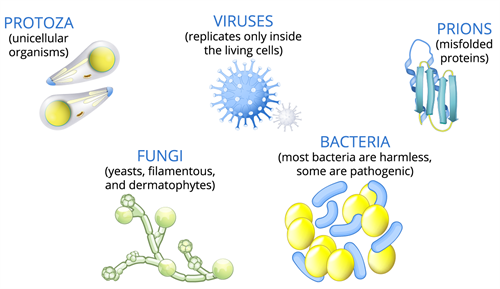PDF chapter test TRY NOW
In the previous section, we provided in-depth knowledge on the concepts of various microorganisms, characteristic features, and structures. This section will be dedicated to Microbes and disease, where we can explore the different types of illness in great detail.
Any functional or physical change from the normal state that causes discomfort, disability, or impairs a living organism's health is called a disease. The study of disease is called pathology.
Meaning of health:
Health may be described as a state of complete physical, mental and social well-being and not only the absence of disease.
What is a disease?
Health is a state of proper functioning of body and mind. All the body functions are interconnected. Anything that stops the proper functioning of cells and tissues will lead to a lack of appropriate body functioning. Various agents can cause this malfunctioning at the level of cells, tissues, organs or organ systems.
Infectious agents:
The unicellular or multicellular organisms that cause infection are called infectious agents.

Types of infectious agents
As we already learnt that, these disease-causing organisms are called pathogens. The biological agents such as viruses, bacteria, fungi, protozoa or stress, and any other immune system failure led to the state of illness and health failure. This condition is known as disease (dis = against; ease = comfort). In the presence of a disease, functioning or the appearance of body system may change. These changes give rise to symptoms and signs of disease.
Symptoms of diseases are the general indications that we feel as wrong or uneasy such as cold, headache, cough, vomiting, diarrhoea, etc. These all are the symptoms indicating a disease, but they do not precisely show the condition. For example, a stomach ache may rarely mean abdominal cancer; it merely means just due to stress or any digestion problem.
Diseases can be broadly classified into four groups.
1. Classification of diseases based n the extent of occurrence:
- Endemic disease
- Epidemic disease
- Pandemic disease
- Sporadic disease
2. Diseases can be classified based on the cause:
- Infectious or Communicable disease
- Non-infectious or Non-communicable disease
3. Diseases can be classified based on the causative organism (pathogen):
- Bacterial infection
- Viral infection
- Fungal infection
- Protozoal infection
4. Based on a different mode of transmission, diseases can be classified as:
- Airborne diseases
- Waterborne diseases
- Vector-borne diseases
